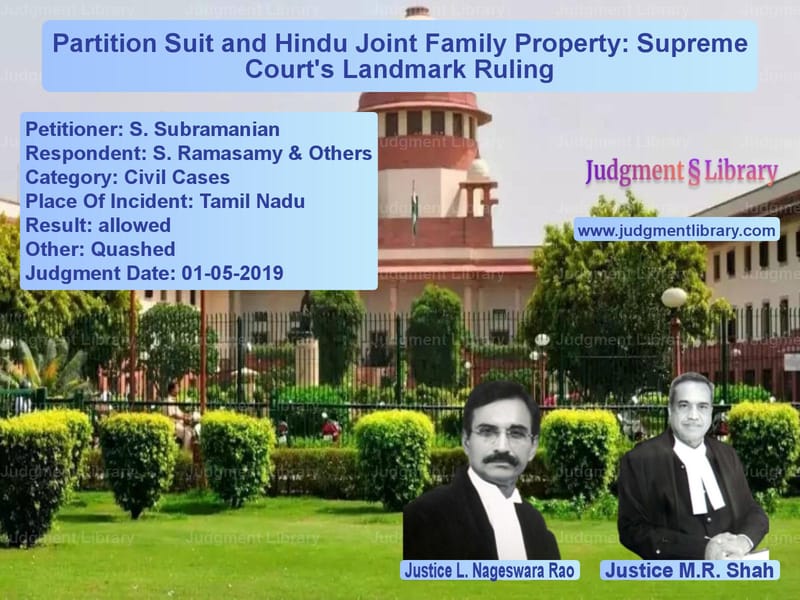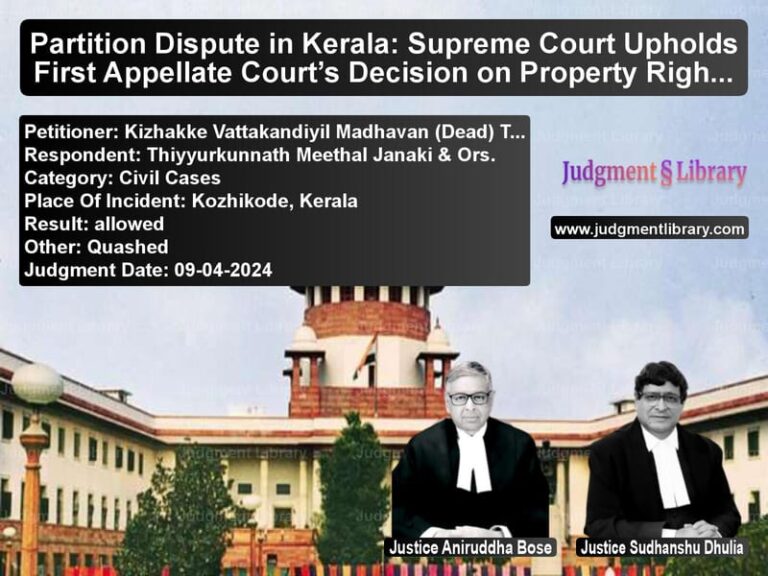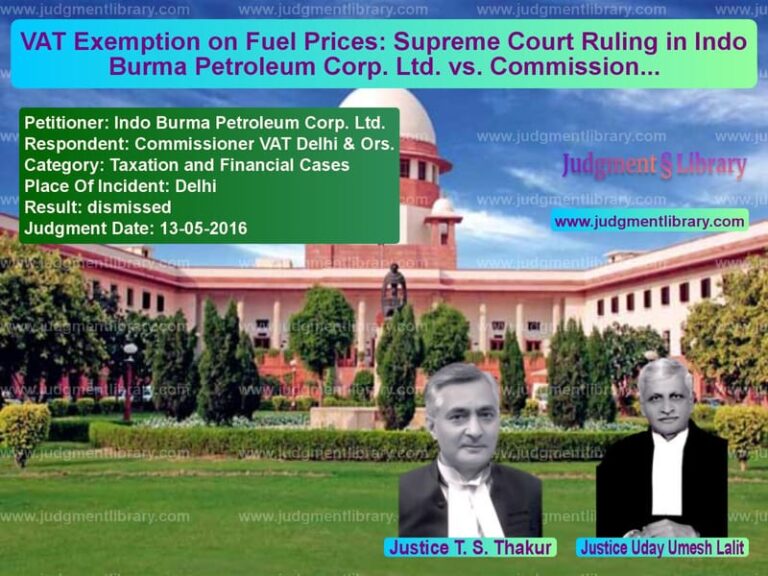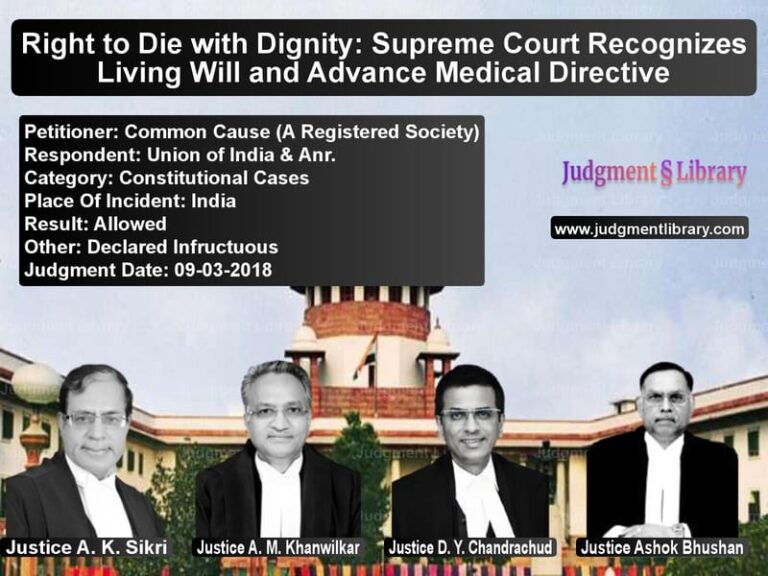Partition Suit and Hindu Joint Family Property: Supreme Court’s Landmark Ruling
The case of S. Subramanian vs. S. Ramasamy & Others revolves around a legal dispute concerning the partition of family property under Hindu law. The Supreme Court examined whether the properties in question were part of a Hindu Joint Family or were self-acquired by the father. The judgment set a precedent on the interpretation of ancestral property, blending of separate properties into joint family assets, and the powers of High Courts in second appeals under Section 100 of the Civil Procedure Code (CPC).
This ruling also dealt with the question of whether the High Court could re-appreciate evidence when both the trial court and first appellate court had dismissed the suit for partition. The Supreme Court overturned the High Court’s decision and restored the lower courts’ verdicts, reaffirming the limitations on the exercise of power under Section 100 CPC.
Background of the Case
The dispute originated from two civil suits concerning property ownership. The plaintiff, S. Ramasamy, filed a suit seeking partition of family property, claiming an equal share. The plaintiff argued that the property was part of a Hindu Joint Family estate and that his father had no absolute right to alienate or transfer it.
The defendant, S. Subramanian, contested the claim, asserting that the properties were self-acquired by their father, Sengoda Gounder, and were not part of any joint family estate. The defendant provided evidence of settlement deeds and a will executed by their father, transferring ownership to him.
The trial court dismissed the suit, ruling that the properties were self-acquired. The first appellate court upheld this decision. However, the High Court, in a second appeal, reversed these findings and granted partition rights to the plaintiff. The defendant then approached the Supreme Court.
Legal Issues Considered
- Whether the properties in question were ancestral or self-acquired.
- Whether the act of blending could be inferred from mere possession and usage by family members.
- Whether the High Court had the jurisdiction to re-evaluate evidence in a second appeal under Section 100 CPC.
- Whether the plaintiff’s second suit was barred by Order 2 Rule 2 CPC.
Petitioner’s (S. Subramanian) Arguments
- The properties were self-acquired by their father, not ancestral, as they were obtained from a maternal relative.
- The father executed settlement deeds and a will in favor of the defendant, proving individual ownership.
- The High Court exceeded its jurisdiction under Section 100 CPC by re-appreciating evidence and overturning concurrent findings of fact.
- The plaintiff had initially filed a suit for an injunction and later filed a partition suit, violating Order 2 Rule 2 CPC.
Respondent’s (S. Ramasamy) Arguments
- The properties were treated as joint family properties, with all members residing and managing them together.
- Loans were taken using the properties, demonstrating joint family ownership.
- The High Court correctly identified blending of the self-acquired property into joint family property.
- The earlier suit for injunction did not preclude a later suit for partition.
Supreme Court’s Observations
The Supreme Court ruled that the properties were self-acquired by the father and had not been blended into joint family property. The Court emphasized:
“Merely because family members reside together or jointly manage properties does not lead to an inference of blending. Clear intention to abandon separate ownership must be established.”
The Court further ruled that the High Court had overstepped its jurisdiction under Section 100 CPC:
“A High Court cannot interfere with concurrent findings of fact unless there is a substantial question of law. Re-appreciating evidence in a second appeal is impermissible.”
The judgment also clarified that Order 2 Rule 2 CPC did not apply in this case, as the cause of action for partition arose separately.
Key Findings of the Supreme Court
- The properties in question were self-acquired by the father and not part of a Hindu Joint Family.
- Blending requires clear intention to treat self-acquired property as joint family property, which was absent in this case.
- The High Court erred by re-evaluating evidence and interfering with the lower courts’ findings.
- Order 2 Rule 2 CPC did not bar the plaintiff’s suit for partition.
- The judgment of the High Court was set aside, and the trial court’s verdict dismissing the suit was restored.
Final Verdict
The Supreme Court allowed the appeal, restoring the lower courts’ decisions. It held that the High Court had no authority to interfere with factual findings without a substantial question of law. The judgment reinforced the principle that self-acquired property remains separate unless clear evidence of blending exists.
Implications of the Judgment
This ruling has significant implications for property disputes under Hindu law. It clarifies that mere family management or residence does not transform self-acquired property into joint family property. The judgment also restricts the powers of High Courts in second appeals, ensuring that they do not act as fact-finding courts.
The case serves as a crucial precedent in partition disputes, reinforcing the importance of documentary evidence in proving ownership claims.
Petitioner Name: S. Subramanian.Respondent Name: S. Ramasamy & Others.Judgment By: Justice L. Nageswara Rao, Justice M.R. Shah.Place Of Incident: Tamil Nadu.Judgment Date: 01-05-2019.
Don’t miss out on the full details! Download the complete judgment in PDF format below and gain valuable insights instantly!
Download Judgment: S. Subramanian vs S. Ramasamy & Others Supreme Court of India Judgment Dated 01-05-2019.pdf
Direct Downlaod Judgment: Direct downlaod this Judgment
See all petitions in Property Disputes
See all petitions in Succession and Wills
See all petitions in Landlord-Tenant Disputes
See all petitions in Judgment by L. Nageswara Rao
See all petitions in Judgment by Mukeshkumar Rasikbhai Shah
See all petitions in allowed
See all petitions in Quashed
See all petitions in supreme court of India judgments May 2019
See all petitions in 2019 judgments
See all posts in Civil Cases Category
See all allowed petitions in Civil Cases Category
See all Dismissed petitions in Civil Cases Category
See all partially allowed petitions in Civil Cases Category







